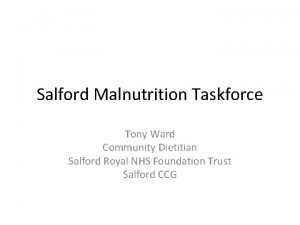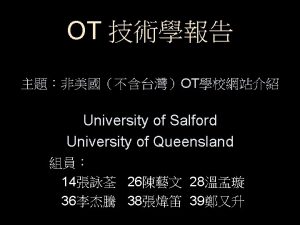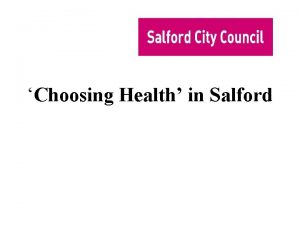Salford Royal Dining Companions Dining Companions How it








- Slides: 8

Salford Royal Dining Companions

Dining Companions – How it started The idea for having dining companions on our wards came after one of our long serving volunteers’ husband sadly passed away on L 5 in summer 2018. Our Volunteer, Francis disclosed to our team and the nursing lead that she was upset about the lack of support available for her husband at mealtimes. She felt that if she hadn’t of been their each day he would not of received the assistance needed, as ward staff as they were rushed of their feet and ultimately he would of missed crucial meals. 2

Poor nutrition in hospital leads to: • • • Medicines and surgery not working so well Poorer healing Longer stay in hospital Feeling low Good nutrition whilst unwell Less energy • Small frequent meals Staying in bed more • More high fat/high sugar items • Milky drinks • Snacks between meals • Using nutritional supplements 3 looks like:

Consequences & costs Consequences of malnutrition creates an increased use of health services Traits evidenced from malnourished people; ❖ ❖ , Saw their GP twice as often Had three times the number of hospital admissions Stayed in hospital more than three days longer than those who were well nourished Have more ill health (comorbidities) Clinical Nutrition, Volume 30, Issue 4 Costs to system ❖ To the health and care system was around 19. 6 billion in 2011 - 12 ❖ It is two to three times more expensive to treat someone who is malnourished ❖ Estimated health and social care expenditure per capita of the population is £ 2, 417 ❖ For those malnourished or at risk, the expenditure rises to £ 7, 408 person http: //www. bapen. org. uk/pdfs/economic-report-short. pdf 4

Outcomes we wanted to achieve 5

Salford Royal ward profiles stage 1 Ward Description Beds Avg LOS Ward manager ANU Acute Neuro Surgery 30 2 weeks Ann Marie Elt B 6 Surgery & Orthopaedics 32 1 - 3 weeks Irene Weaver L 3 Ageing & complex medicine 27 4 - 6 weeks Adrian Edwardson L 5 Elderly Care 24 4 - 6 weeks Vikki Dean ASU Acute Stroke 22 3 days Marco Silingardi Hyper Acute Stroke 17 3 days Rebecca Jones 6

Collabrative working The steering group was set up early in the project, and has made a huge difference to getting buy in from staff and clinical staff engagement. We cannot underestimate the amount time and value of engaging directly with staff. The steering group membership isn’t static due to the needs of the group and hospital shift patterns. The steering group consists of representatives from across the Trust; ❖ ❖ ❖ ❖ ❖ Dietician Speech Therapist Patient Experience Quality Improvement Data team Ward staff Ward manager Volunteer Team Project Manager Helpforce 7

Volunteer led approach ❖ Volunteers receive bespoke training developed and delivered by our Dieticians and Speech and Language Therapists ❖ Volunteers are monitored on the ward; their confidence levels are captured by observation and a survey ❖ Ward champions role has been developed for clinical staff ❖ Flexible volunteer hours ❖ Snacks to be actively distributed 8
 Young person from the provinces archetype
Young person from the provinces archetype What news does bottom bring his companions?
What news does bottom bring his companions? Some wounds are unhealable carl jung
Some wounds are unhealable carl jung Supernatural intervention archetype definition
Supernatural intervention archetype definition Death and rebirth archetype examples
Death and rebirth archetype examples Closest companions of prophet muhammad
Closest companions of prophet muhammad Why dogs make good companions
Why dogs make good companions Fire vs ice archetype examples
Fire vs ice archetype examples Salford discretionary housing payment
Salford discretionary housing payment














